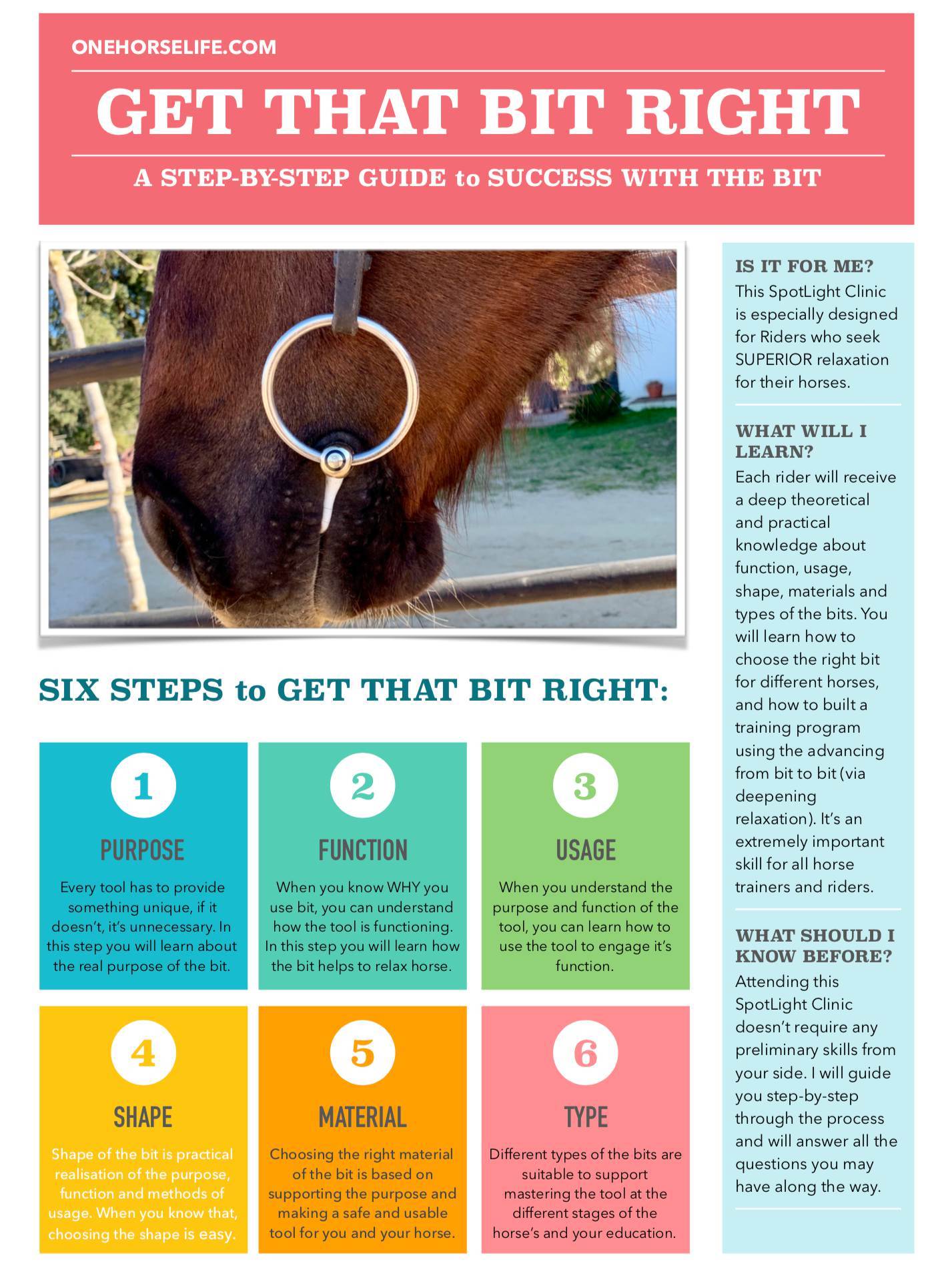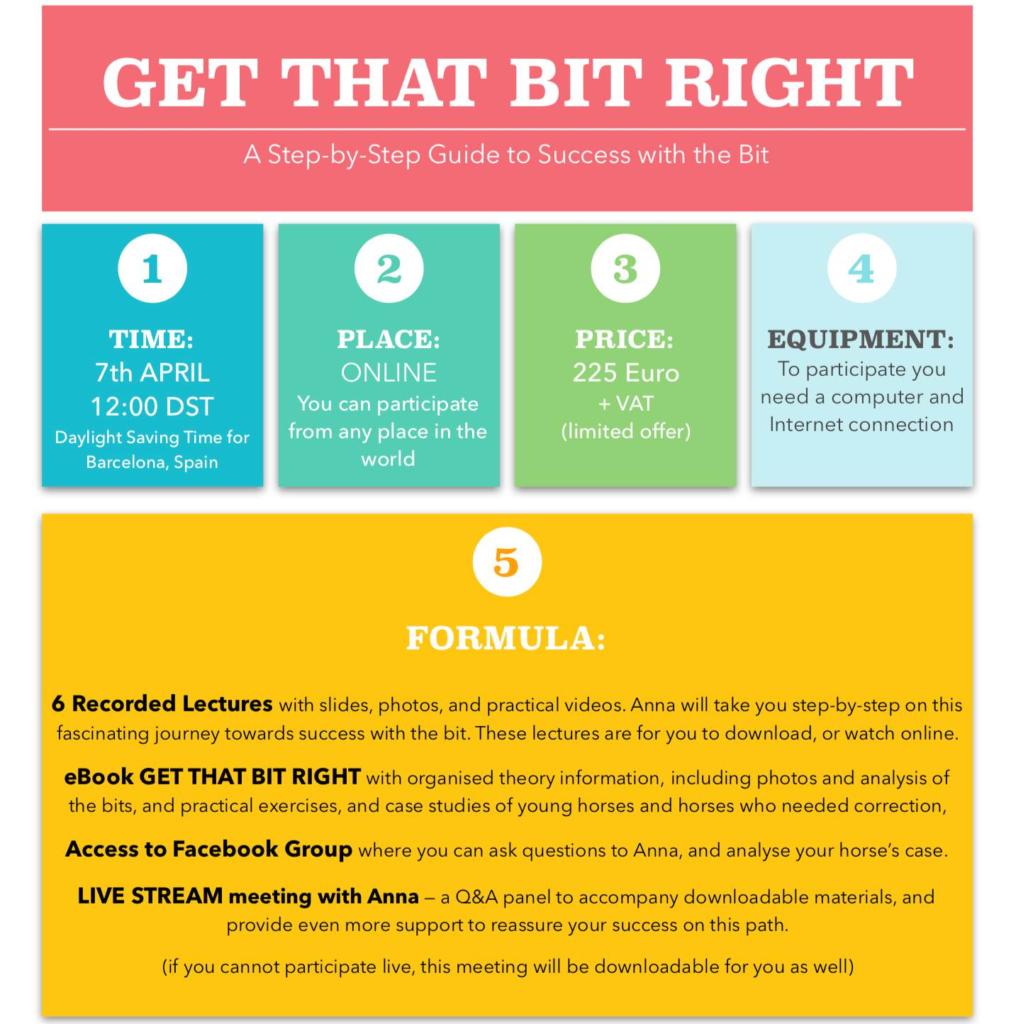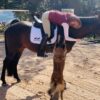Many people turn away from riding with the bit. We all can see how much abuse is happening in the today’s world connected with misusage of the bits, pulling and pressure, harsh bits, stiff hands and tight nosebands. What is the source of this situation, and do we need bits when riding our horses at all? And if so, what purpose would they need to serve?
GET THAT BIT RIGHT
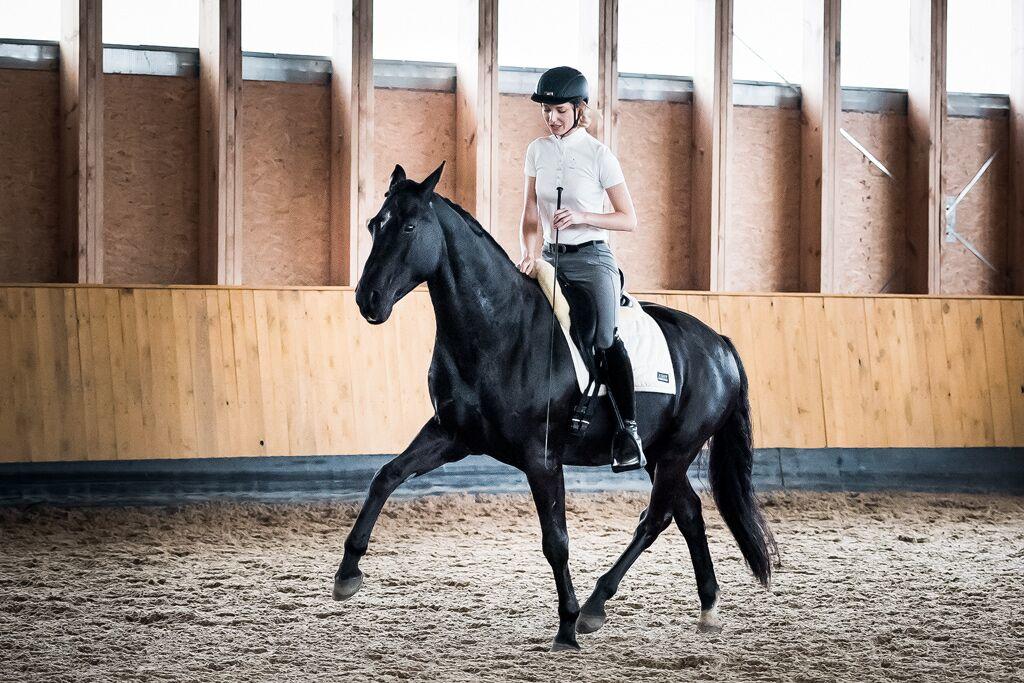
WHAT IS THE PURPOSE OF THE BIT?
Every tool has to provide something unique for the user, and if it doesn’t provide anything unique, it means that it’s unnecessary.
This is the understanding of many people, and they are absolutely correct: If they don’t see or don’t know (or understand) the purpose of the bit, this tool becomes unnecessary in their training. Many people believe that riding without the bit is superior to riding with the bit, because it shows that the rider can stop or turn the horse without pressure onto the horse’s mouth, and that the horse still obeys to the rider, even if there is nothing he can fear, or nothing through which the rider can control his horse.
In fact, all riding manoeuvres don’t require presence of the bit at all, and the true obedience, which for the purpose of this article should be rather called cooperation or two-way understanding — cannot be based on fear, force or control. For stopping, turning, and riding a horse one doesn’t need a bit at all. And we most definitely don’t need one to create the partnership with our horse as well.
So for what do we need the bit?
The main purpose of it is to provide possibility for the rider to relax his horse to the deepest possible levels WHILE executing movements, which would normally cause tensions to the horse’s body, and excitement to his mind.
Many people use the bit through pressure. In my eyes, this happens when people don’t understand neither the purpose nor the function of the bit. It’s very typical for all of us turn to pressure whenever we are stressed and don’t know how to do something, for example:
- When people don’t know how to communicate, they become aggressive towards one another,
- When people don’t know how to nurture their bodies, they abuse their bodies with diets,
- When people don’t know how to fix their TV, they start to hit it with a hand.
When people don’t know how to do something, they turn to pressure. The same happens with the bit. But in this moment it loses it’s purpose and doesn’t serve it’s function anymore. Remember, the function of the bit is to relax the horse. Relaxation of the horse is not a “nice addition to the training”, it’s a base to all of the exercises you want to do later with your horse from the saddle.
Deep body relaxation is a prerequisite and an integral part of all dressage exercises.
When we see the purpose of the bit as the tool to provide and deepen Relaxation of the horse’s body (as opposed to control or means to submit the horse to the will of the rider), then many of the dressage exercises start to appear spontaneously: when the horse’s relaxation of the body increases, it’s possible and easy for him to move in certain way. Bit is the means of relaxing the horse, and dressage exercises are the means to measure the achieved relaxation while in the action.
For example: the rider doesn’t have to practice haunches-in in order to flex or supple the hind legs of the horse. Rider relaxes the horse deeply through the bit, and then rider checks his work by entering the haunches-in position to see whether his feel for the relaxation of the horse was correct, and if the horse is able to enter the exercise and maintain relaxation of the hind legs in it.
Another example: the rider doesn’t have to practice shoulder-in to supple the ribcage of horse. In fact entering this exercise with this purpose could tense the horse even more (if he enters it already tensed!), rider would have to pull and use force in order to keep the horse in this position. With the support of the bit, the rider feels whenever the horse relaxes deeply, and he enters the shoulder-in position to check if the ribcage and spine column of the horse is relaxed enough to allow such a flexion. Full body flexion of the shoulder in can be done only through the deep relaxation of the skeletal muscles of the horse on both sides of the spine, and the bit can become the means to reassure that the horse is relaxed equally at all times, and allowing him to enter shoulder-in position at any chosen moment.
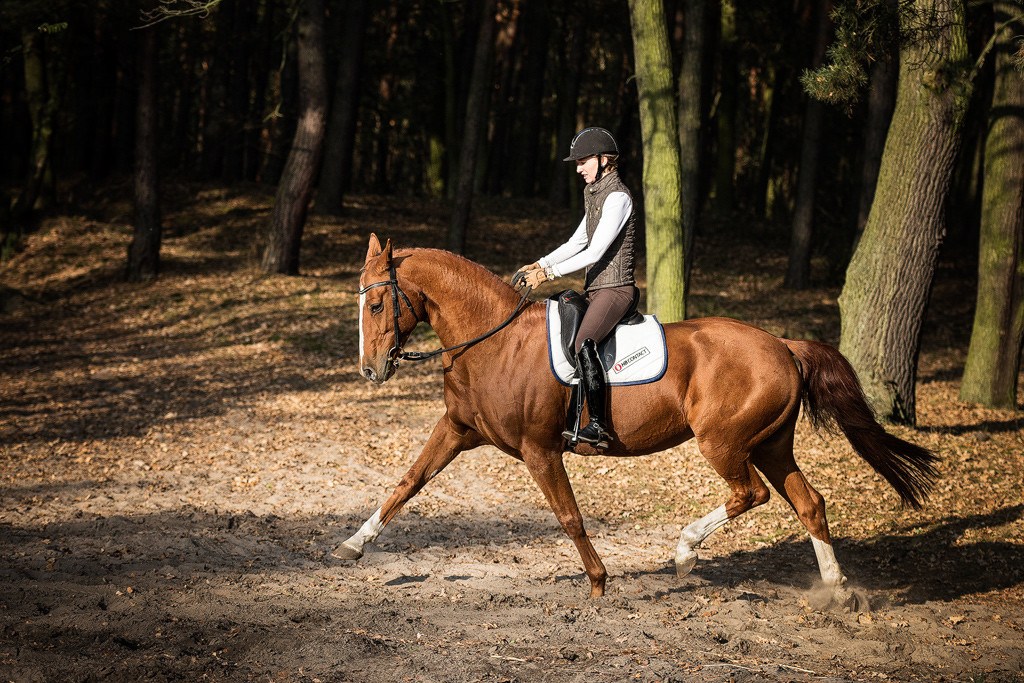
FUNCTION OF THE BIT
When you know the purpose of the bit, you can understand and discover how this tool may be functioning to support this purpose:
Relaxing of the horse through the bit is not a new concept, in fact it’s a very old concept promoted and mentioned in many horsemanship schools and throughout many centuries. But in order to do this successfully one needs to understand WHAT IS RELAXATION and HOW RELAXATION WORKS.
Many people want to learn how to relax the horse with the bit. It only shows how important this topic is for them, and how many riders and horse owners want to learn how to do this. In my career as horse and riders trainer I experienced many times that even the most skilled and experienced riders who mastered bit-less and bridle-less riding with their horses, still experienced challenges when riding with the bit. Yet, they wanted to cover this blank in their education, and trusted it may be possible for them to achieve even deeper relaxation with the bit, than without it.
WORKING METHODS
Methods which are working, which are gentle to the horse and provide clarity to the rider are focused on relaxing the horse on the bit through the flexions of the jaw. From my perspective, this is touching only the surface of Relaxation which we can offer to our horses with the bit.
Many studies show that professional divers usually have a very tensed jaw. This is because their work require a lot of focus, and constant high level of attention from them. The most common way to support the relaxation of the jaw is to mobilise it. This can be done through massage, keeping the jaw slightly opened every other minute, or simply by chewing the chewing gum few times a day. But mobilisation, which is the first step to relaxation usually it doesn’t solve the cause of problem, just minimise it’s effects.
Process of Relaxation is based on removing tensions from the muscles. The common understanding of this phenomenon is that whenever you clench the muscle you introduce tension, and whenever you stop clenching the muscle, you provide relaxation.
Unfortunately for us (humans and horse trainers) the moment when the flexion ceases, doesn’t provide full relaxation of the muscle! The muscles are still tensed: even when they are at rest, they are still excited by the electric current going through (only less when compared to the full flexion, and full engagement). This phenomenon and the tensions present in the muscles even when they are inactive are called RESIDUAL TENSIONS.
When you or your horse have Residual Tensions it means that the electric current is flowing through your muscles constantly but in small amount. This situation ultimately means that the electric current stimulates your or your horse’s Central Nervous System all the time, and makes it not possible to function properly (due to being all the time occupied with these small electric currents which stimulate it).
In effect, all the motor, cognitive and emotional functions of your and the horse’s body are disturbed.
Residual tensions stand behind anxiety, stiff movement, lack of energy, unresponsiveness, and many health problems (for example: tensions of the digestive tract).
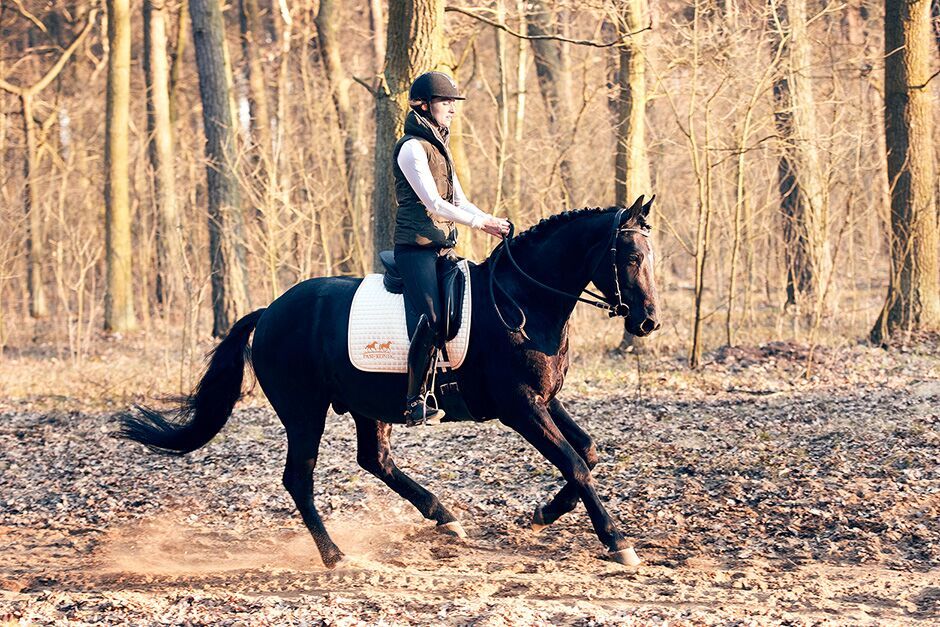
MOBILISATION VS. RELAXATION
Mobilising of the horse’s jaw through the jaw flexions will release the most important, yet at the same time most superficial tensions of the body which are usually the skeletal muscles tensions, but will not, unfortunately, provide release of the residual tensions from the horse’s body. Why is that so?
Releasing Residual Tensions from the body requires a special technique, which is not based on mobilising of the body parts or of the muscles in order to start the release. Movement and mobilisation of the muscles causes some stimulation, which you can later take away, but then the body comes back to the previous level of residual tensions.
With the help of the bit the rider can feel the residual tensions of the horse’s body, and can release them through special technique of relaxation of his own hand. In the technique I want to share with you, you won’t use flexions of the jaw to provide mobilisation, or provoke the release. You are going to use only special techniques for relaxation of the rider’s hands.
The bit becomes a new tool with an even deeper meaning, which allows the rider to feel the residual tensions of the horse, and supports the horse in releasing these tensions in the most quick, easy and efficient way. Doing this without the bit would take much longer time, and many times – in case of so many horses who lack perfect confirmation, and therefore who collect and carry everyday a lot of residual tensions in their bodies and cannot access relaxation consciously – would be impossible.
UNDERSTAND THE FUNCTION, UNDERSTAND THE BIT
Without understanding the function of the bit, we cannot understand how to use it, and why one bit is better than the other one, which shape of the bit to use and at which stages of the training, and what materials support our goal (releasing residual tensions from the body) in the best possible way.
Setting the reason of the tool in such a way is a shared goal of the rider and the horse, and makes the horse WANT TO HAVE THE BIT IN HIS MOUTH.
The goal for you may be: “I want to release residual tensions from my horse’s body through the bit to have a horse who is better relaxed, less spooky, learns quicker, have a better access to respiratory tract, and moves with better balance and with fully flexible limbs.”,
At the same time, your horse will want the bit in order to release residual tensions from his body with your help, because thanks to this experience he simply feels better, is healthier, stronger, and has less pain in his body.
People know that it’s good when the horse WANTS to have the bit in his mouth, but the methods to introduce it to the horse show that we don’t see it as anything pleasurable: people click their horses in order to teach them to open their mouth, give treats, or put the finger into the horse’s mouth in order to open it and make the horse take the bit. This all shows that we feel that there is NOTHING FOR THE HORSE in having the bit in his mouth, we don’t see any reason WHY the horse would want that. And this is also the reason behind the success and popularity of the bit-less riding movement.
Thanks to the Residual Tensions Release offered by the bit for the horse, the bit becomes the tool equally profitable for the horse as for the rider. You will not have to use treats or click your horse to teach him to take the bit into his mouth. Your horse will want to do that, simply because he will associate the bit with something that helps him relax (in the same way as you associate doing yoga, meditating, doing BodyMarc, or getting a massage with a lovely feel in the body you have afterwards):
In the video above you can see my 5yo young horse, who spontaneously takes bit into his mouth during a grooming session, and plays with it. The tool you use for your horse will mean only as much as you are going to give it. Clearly, for my young horse Darcy bit has no bad associations, but is deeply connected with being relaxed (and therefore playful and feeing good), and this memory is something that makes him so eager to practice putting on the bridle and taking the bit in even during grooming preparation for the training session. Caution! This is NOT an apple-flavoured bit! ;-)
From the perspective of the rider, understanding and defining the FUNCTION OF THE BIT through Residual Tensions Release takes away all the stress of using the bit for the horse and the rider, and provides a bigger purpose for both of them in what they do.
USAGE OF THE BIT
The active side of using the bit, is the rider and his hand — the rider provides action, and horse receives it.
This part already can create some problems: if the rider doesn’t understand the function nor the purpose of the bit, he will misuse it (abuse it) by pulling with it, and trying to control the horse or execute the movements through the bit.
If the rider relaxes the horse through the flexions of the jaw, he will be moving his hand and changing the position of the bit in the horse’s mouth to start the relaxation and mobilise the tongue of the horse.
If the rider wants to release Residual Tensions from the horse’s body with the bit, through the technique that I want to introduce to you, he will keep the bit as steady as possible, to feel the residual tensions of the horse, connect with them and release them through his hand using a very specific technique.
This means that Releasing Residual Tensions from the horse’s body through the bit can become the next step for everyone who already uses jaw flexions, by allowing an even deeper reach into the horse’s tensions and provide the NEXT STEP refinement of their practice. But at the same time it will be equally suitable for all riders unfamiliar with flexions of the jaw, and a great starting point for everyone who wants to start relaxation with the bit with their horse to better movement, cognition, well-being and health of their horse.
CORRECT USAGE OF THE BIT BETTERS SEAT OF THE RIDER
When the rider is not pulling on the bit, and doesn’t use the hands and arms to counter-act the pulling of the horse, many tensions of the rider’s body can cease. This creates a very unique situation, in which the body of the rider can start to use all the micro-tensions and micro-releases in order to enter the state of so called active balance, which very similar to the balance a person has when standing on a fitness ball:
In the same way, as you cannot find your equilibrium and balance when standing on the Swiss Fitness ball if you have some sections of your body constantly tensed, it is virtually IMPOSSIBLE for the rider to have elastic, active and balanced, quiet seat if he is constantly tensing his abdomen, hands, arms, or back muscles in order to balance pulling on the bit by the horse!
When the rider achieves full mouth relaxation of the horse, the horse instantly starts to swing with the back. When the horse’s back swings, ability of the rider to sit well betters almost instantly, and allows the rider to apply very precise and subtle aids. What is more, relaxation of the hands, arms and the back of the rider instantly pushes the centre of gravity of the rider down, allowing even better balance. All of this, of course improves the horse’s movement and balance instantly.
LESS STIFFNESS & PAIN, MORE FUN FOR EVERYBODY
The rider’s seat and weight become the only aids to turn, stop and shift balance between the sides of the horse’s body, and the hand is continuously occupied with relaxation of the horse’s jaw, and thus constantly relaxed itself. This immediately relaxes the whole body of the rider, arms, shoulders, back and abdomen, and allows a balanced, functional, active yet extremely quiet and efficient seat for the rider.
On top of that it decreases hugely back pain experienced by so many riders, who unconsciously tense their arms and hands on the bit in order to control the horse, or have horses who pull on the bit or are heavy on the contact.
From the perspective of the horse such a usage of the bit by the rider makes the signals and aids more clear, and understandable: Hand serves the purpose of deepening the relaxation, and seat is a means to execute the route, riding and the exercises. The hand of the rider prepares the horse’s body by deepening it’s relaxation to receive the aids of the rider seat, and better the horse’s balance.
When the horse is very deeply relaxed, his body melts with the body of the rider. Such riding looks like the horse’s and rider’s bodies are ONE, they move effortlessly and without disturbing each others balance.
SHAPE OF THE BIT
In the common training riders choose soft bits at the beginning, because they see how much disturbance having the bit in the mouth causes to the horse. This situation (horse’s stress when with the bit in the mouth) is caused by either inability of the rider to choose the right (size, type, shape) bit for their horse, or by the fact that no-one introduces the horse to the bit through Relaxation, and show the horse how great the bit can support him to feel better. The training progresses and as the horse “tolerates” the bit better, the rider gradually moves to use more and more powerful bits with refining the usage of them (for example: advancing from rubber or synthetic bits used with the young horses, through metal bits with advancing horses, to the cub-bit for advanced horses as the years go by and the training of the horse advances) in order to have better ability to achieve relaxation and lightness. Or at least it’s the theory.
Without teaching the horse how to relax on the most simple bits, the horse won’t be able to achieve relaxation on more complicated bits, or sharp bits. Such advancing will be even contradictory to the theoretical goal of the rider (which is to provide more relaxation, balance and lightness).
START FROM THE SQUARE ONE
For the purpose of Residual Tensions Release we we start from the most simple bits, and we spend time on teaching the horse how to relax to the deepest possible levels at this stage. When this is achieved, our refinement will go in the direction of the more soft and precise bits (but not necessarily sharper bits), with the shape which allows even better release of Residual Tensions from the horse’s body.
In this point, you will learn how to chose the best bit to start with your horse. I will show you which bits are suitable for introducing your horse to Residual Tensions Release, and what shape of the bit is good for which stage of the training of the young, and the advancing horse. I will help you to draw a training plan, and a plan how to progress from bit to bit and when, and how to measure the success of your work and know if you and your horse are ready for the next bit.
The shape of the bit must allow the rider to feel the residual tensions of the horse, and transfer his relaxation onto the horse’s mouth without movements of the hand at every stage of the training.
This automatically makes many of the bits available on the market completely unsuitable for our purpose, but at the same time greatly simplifies the process of choosing the right bit and making a training plan for your horse which includes progression from bit to bit.
MISCONCEPTIONS
Unfortunately, the wrong training caused by lack of understanding of the purpose of using the bit affected the market, and made companies produce many bits that reflect not the advancement and level of relaxation of the horse, but the problems in the training that occurred due to wrong purpose, and execution of the bit’s function through the usage.
Usually the bits are divided into three categories:
- Bits for young and sensitive horses who shy and don’t come into the contact easily,
- Bits for horses who have tensed mouth, are strong, heavy or forceful.
- Special bits for horses who have tongue problems or resist the rider.
These three categories show that, unfortunately, most of the riders don’t know the purpose of the bit, it’s function, and cannot (or don’t know how to) use it properly. Remember, that when a person doesn’t know how to use something and feels opposition, they tend to apply pressure (vide: TV, and a hand that hits it).
These three most common categories of the bits don’t really speak about the problems horse’s have, and how to solve them, but they point at what went wrong with the training.
The solution to this situation is not to change the bit to more harsh or more soft, or to the one with a different shape, but to change the way the rider uses the bit, and change the bit to the one which shape, material and type would support the horse to relax better at the stage of the training of achieving relaxation that the horse and rider are at.
To execute it, the rider needs to reconnect with the PURPOSE of the bit, FUNCTION of the bit, and understand the USAGE of the bit. Then, the rider must evaluate the level of Relaxation of his horse with the current bit. Based on that, the choice of the SHAPE of the new bit, will be super easy. The rider will chose the shape which will support in the best way the release of the tensions of the horse’s body given the stage of the horse’s education, tension, and acceptance of the bit.
Now, we move to the material, because when we know the shape, level of tensions in the horse’s body, and the purpose of using the bit, we will understand easily which materials support release of the tensions, and which will not be helpful with that.
Before we do that, let me focus your attention on one more thing: LET GO OF THAT NOSEBAND!
In the common training people use bridles with nosebands and flash-nosebands, in order to keep the mouth of the horse shut, and to make it difficult for the horse to escape the pressure caused by the bit, for example by sticking his tongue out, or opening the mouth, or moving the bit up onto the molars.
I unfortunately have seen, even at the dressage clinics run by Olympic Dressage riders, that the solution to the behaviours is to tighten the noseband even more. Such a HUGE mistake! These behaviours show lack of acceptance of the bit and lack of relaxation on the bit on the end of the horse, and lack of understanding of the purpose, function and usage of the bit on the end of the rider, and are an alarm to not continue the current training, but to come back to square one:
- Educate the rider about the purpose, function and usage of the bit,
- Educate the Horse, teaching him about the jaw relaxation via mobilisation (flexions of the bit), and then release from the horse’s body all Residual Tensions through Residual Tensions Release with the bit (technique which I am going to teach you).
It your horse falls into category of any mouth problems, such as:
- pulling out the tongue,
- biting of the bit,
- clenching of the jaw with the bit,
- heaviness on the bit,
- pulling on the bit,
- stiffness of one or both sides of the body,
- tilting at the poll,
- stiffness of the pelvis and hind legs,
- lack of movement through the back,
- overdevelopment of the under-neck muscles,
- swelling of the parotid glands,
- dead mouth.
– Don’t worry! With the technique of Releasing Residual Tensions from the horse’s mouth with the bit, you are going to learn how to gradually and steadily improve your horse’s relaxation in such a way that these behaviours will simply disappear. You won’t need flash nosebands, dropped nosebands, or any other types of nosebands. You won’t need to giggle, pull, vibrate or move the bit in your horse’s mouth – which is especially difficult and frustrating if the horse’s mouth is already very very tensed, un-stable, and the horse is chomping on the bit all the time.
I will show you the working technique which will allow you to detach the noseband from your bridle for good, and enjoy the calm, steady, and soft mouth of your horse. It will come naturally, and very easily. This release will affect your horse’s hind legs, pelvis, sacroiliac joint, way his back swings and is muscled-up, and freedom of your horse’s shoulders.
Your horse will enjoy unlimited breathing (which is absolutely essential for a sport athlete and to maintain full body relaxation), full ability to mobilise his jaw and express any tensions he will be experiencing. And we will want to see these tensions, we will never want to hide them. Because seeing them, understanding the reason behind their appearance is the only way of releasing them for good.
MATERIAL OF THE BIT
People escape metal bits, in favour of the synthetic, rubber or leather bits because they are afraid that with the metal bit they can cause discomfort or distress to their horse. This is also a reason why so many people turn to bit-less bridles.
I believe that for many people using the rubber, leather or synthetic bits can be a good choice. These materials are, of course, very flexible, and will bent under the pressure of the rider’s hand whenever the horse tenses, or whenever the rider pulls or tenses his hand. People hope that in case of sudden movement of the horse, or lack of rider’s balance the “soft bits” will provide a “safety-net” for the sensitive mouth of the horse.
However, if you have doubts about your horse’s calmness, and your balance in the saddle, probably it’s better to not use bits at all, no matter what material they are made of.
I was a firm believer in the superiority of the synthetic, rubber, and leather bits over metal bits for many years, and was a big fun of all “soft” bits myself, until I fully realised their limitations, all the potential deception they can cause. Let me explain what I mean…
For the purpose of Residual Tensions Release with the bit, we need a very specific type of material from which the bit is made. This material must allow transmission of the feel of the residual tensions in the horse’s jaw onto the rider’s hand, and then transmission of the relaxation of the rider’s hand onto the horse’s jaw. This automatically means that this material must be stiff, and must not flex on it’s own.
This means that only metal bits are suitable for the purpose of our training.
BEFRIEND THAT METAL
Only stiffness of the bit allows precision in transmitting tension of the horse’s body to the rider’s hand, and relaxation of the rider’s hand onto the jaw of the horse.
The synthetic, and rubber bits don’t serve this purse, because they change the feeling of the rider’s hand, and they allow the rider to mistake the softness of the bit with the softness of the horse’s mouth (and ultimately his whole body). If this happens, then the rider risks continuing or advancing the training without a properly and deeply relaxed horse. I see that it causes confusion to many riders, they believe that they have “a soft feel” under the bit, but in fact it’s not “under the bit”. It’s the soft feel of the bit, and not of the horse.
For the purpose of releasing tensions from the horse’s jaw, the rider needs as precise tool as possible, made of material which transmits the forces without any distortions or glitches: this applies both to the bit, which must be stiff and not flexible, and to the reins, which must be stiff and not flexible as well.
The rider needs reins which are slightly stiff, and as light as possible. Leather reins since centuries serve best this purpose, and this is why it’s the material of choice when it comes to connecting the rider’s hand with the horse’s mouth through the snaffle- and double-bit bridles.
There are also synthetic materials, which can be even better than the leather, because they are even lighter yet stiffer than the leather. The key point of choosing these materials is that they must not flex under the weight of the rider’s hands. Rope rains are most of the time not suitable to serve this purpose, as they are too soft.
TYPES OF THE BITS
On the market there are many types of bits, and I know from the messages sent to me from all over the world that the variety and all the different types of bits confuse many riders. People don’t know which type of the bit serves which purpose, and how to chose them. They don’t know if they are using the right bit, for their horse, and which bit they should use next.
Usually the problem with which riders reach out to me is one: the horse doesn’t accept the current bit, tries to spit it out, tenses when with the bit, pulls on the bit, or becomes heavy, and riders come to the conclusion that the bit is wrong, or that they simply have the wrong bit.
Horses cannot relax with the bits, so their owners spend some time unsuccessfully trying to find a good bit for their horse, and then they shift to bit-less. For many horses and riders it’s a good solution. But for those of us who seek to release Residual Tensions from the horse’s body, and achieving full body relaxation while in the most difficult and tension-creating movements, the bit-less option doesn’t provide the means to do that to the fullness.
When we know the purpose behind the bit, it’s function, and therefore how we are going to use it is very clear. Then, we know the shape and material it has to be made of, and then choosing THE TYPE OF THE BIT is very easy.
FROM LESS MOBILITY TO MORE MOBILITY
Depending on the relaxation of the horse, and how well the horse has learned so far to release Residual Tensions from his body with the bit, and mobilise his jaw through the flexions of the jaw (these are two different techniques), the horse will gradually need to more divided, and complex bits (bits with one or two joints), and more movable rings.
Rider evaluates relaxation, and gradually moves from less mobility offered by the bit to more mobility offered by the bit, without losing the stiffness and rigidness of the material and shape it’s made of.
- Rider moves from one piece bits to bits with one and two joints,
- Rider moves from eggbut rings, full side snaffles, and D-ring snaffles to loose rings.
The goal of the type of the bit is to provide or take away mobilisation of the segments of the bit and it’s rings, in order to make it as easy for the horse as possible to understand the function of the bit and relax on it, and in order to enable the rider to feel more precisely horse’s tensions and be able to apply release independently the right and left side. In fact the goal of the rider and the goal of the horse are aligned, and rider will always advance from more rigidness (one piece bits) to more mobility (double joint bits) provided by the chosen type of the bit in order to refine horse’s relaxation and make it more sophisticated.
Join me on the journey to GET THAT BIT RIGHT, and learn even more…
I would love to share with you all my discoveries and findings, experiences, seeking and finding done on this path in the last ten years. And let me support you in finding and re-defining the purpose of the bit, through it’s function, usage… up to choosing the right material, type and shape of the bit suitable best for you and your horse. During this ONLINE CLINIC we are going to go on a deep analysis of over 30 different types of the bits, and how they can support our goal (deep relaxation of the horse) throughout all stages of the training, you will get practical, and theoretical support to GET THAT BIT RIGHT and start new chapter in your riding experience.
Book your seat now for my upcoming SpotLight Clinic: GET THAT BIT RIGHT -> https://gumroad.com/l/GetTHATBITRight
